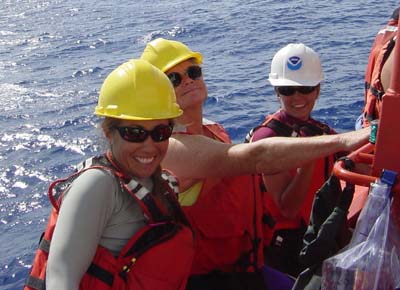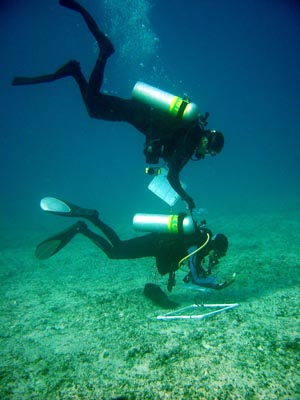|
You
are here: /main/research
expeditions/ 2005 RAMP/10/4/05
REAs
10/4/05
- More REAs
by
David Nichols, State of Hawaii, DLNR, HIHWNMS

REA divers Paula Ayotte, Fenny Cox and
Holly Bollick relax between dives.
We finally arrive at Necker Island, a dry volcanic island
shaped like a fishhook and includes about 45 land acres of
land. Geologists claim it was once the size of O'ahu but waves
have worn down the rest so that it is now a submerged shelf
about 40 miles long and 15 miles wide. There is more than
380,000 acres of coral reef habitat here but severe waves
and currents keep coral growth low in many areas. Necker is
also known by the Hawaiian name Mokumanamana, and is spiritually
significant in the Native Hawaiian culture.
After
spending three days traveling from Kure Atoll to Mokumanamana
the Rapid Ecological Assessment (REA) divers were starting
to dry out. It is obvious they would much rather spend their
time beneath the waters surface. I don’t doubt that
some of them have even retained those gill slits that we all
had early on in our embryonic development. There are a total
of nine REA divers and they perform three dives per day when
the ship isn’t moving us between atolls. Each REA diver
has made around 39 dives this cruise. That is over 350 assessment
dives throughout the NWHI in the past three weeks.
As
I mentioned in an earlier update the REA team consists of
three fish experts (Darla White, Paula Ayotte and Kosta Stamoulis)
who enter the water first, lay the transect lines, then begin
the process of identifying, counting, and estimating the size
of the fish along the line. This will provide insight into
the diversity and richness of fish species in the area as
well as biomass estimates and even age-class structure.

Fish
REA diver Kosta Stamoulis interrupts Holly Bollick as she
searches for invertebrates at Mokumanamana.
After
giving the fish folks some time to do their thing the remaining
REA divers enter the water. This includes the two coral experts
(Greta Aeby and Fenny Cox) who identify and photograph the
corals along the transect to get a better understanding of
the density, community structure and percentage of area covered
by corals. They also monitor the health of the coral in the
area by looking for any bleaching (none was found this cruise),
predators (not a problem in the NWHI), and disease.
The
invertebrate team (Scott Godwin and Holly Bollick) spend their
time along the transect focusing under rubble and in cracks
and crevices in their search for non-coral invertebrates.
The information they collect helps determine the status of
the invertebrate community. The phycology (algae) team (Sheryl
Squair and Richard Osada) are responsible for documenting,
collecting and photographing algae along the transect line.
The process of identifying many algae species requires much
time and equipment that is not available on the ship so samples
are collected to later be identified back in the lab.
Algae
are an important component in maintaining the NWHI’s
ecological balance as a food source for a number of reef organisms,
including the green sea turtle, and also serve as settling
and attachment sites for small and cryptic reef species. Some
205 species of marine algae were identified in 1989 in the
NWHI. Since then, these numbers have nearly doubled and will
continue to increase as the recent collections are fully identified
and recorded.
At
Mokumanamana Cheryl also spends time searching for an alien
alga (Hypnea musciformis) that had been reported
near the island earlier this year. Cheryl performs a deep
dive near one of the areas where it had been reported and
also searches nearshore along Shark’s Bay but finds
no evidence of Hypnea. Shark’s Bay is a high energy,
not-so-protected area on the northwest side of the island.
Today the water is calm enough to allow a search close to
the shoreline. The bottom of almost the entire bay is carpeted
by a green alga, Caulerpa. If an alga is going to
make it on our unofficial NWHI poster then Caulerpa
may be the one. This alga is pretty amazing and difficult
to describe, but each individual plant (I saw some at least
a foot long) is a single cell (with many nuclei). They have
small round nodules associated that look like peas and can
be popped like bubble-wrap. They have a unique ability to
quickly repair any tissue damage or break in the cell wall.
They are definitely tough enough to be considered for our
NWHI poster. I found out later that Caulerpa is edible
but I didn’t have a chance to try it and can’t
vouch for the taste.

REA
diver Richard Osada holds the photographic quadrat (photo-quad)
while phycologist Cheryl Squair examines the area for algae.
Return
to Expedition main page
|